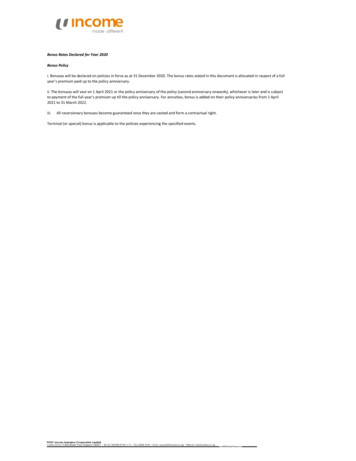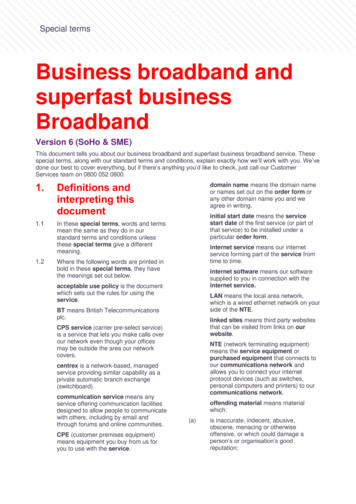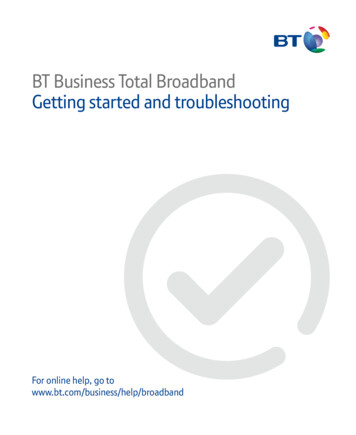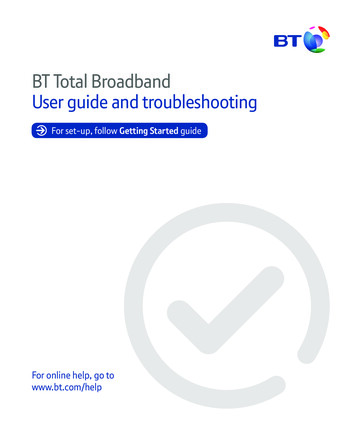
Transcription
NBER WORKING PAPER SERIESTHE BROADBAND BONUS:ACCOUNTING FOR BROADBAND INTERNET'S IMPACT ON U.S. GDPShane GreensteinRyan C. McDevittWorking Paper 14758http://www.nber.org/papers/w14758NATIONAL BUREAU OF ECONOMIC RESEARCH1050 Massachusetts AvenueCambridge, MA 02138February 2009We thank David Burstein, Greg Crawford, Ken Flamm, Barbara Fraumeni, John Horrigan, ChuckJackson, Scott Savage, Alicia Shems, Dan Sichel, Ali Yurukoglu, and Philip Webre for useful conversations.We thank the Searle Foundation and the Kaufman Foundation for funding. All errors are our responsibility.The views expressed herein are those of the author(s) and do not necessarily reflect the views of theNational Bureau of Economic Research.NBER working papers are circulated for discussion and comment purposes. They have not been peerreviewed or been subject to the review by the NBER Board of Directors that accompanies officialNBER publications. 2009 by Shane Greenstein and Ryan C. McDevitt. All rights reserved. Short sections of text, notto exceed two paragraphs, may be quoted without explicit permission provided that full credit, including notice, is given to the source.
The Broadband Bonus: Accounting for Broadband Internet's Impact on U.S. GDPShane Greenstein and Ryan C. McDevittNBER Working Paper No. 14758February 2009JEL No. L86,O33,O47ABSTRACTHow much economic value did the diffusion of broadband create? We provide benchmark estimatesfor 1999 to 2006. We observe 39 billion of total revenue in Internet access in 2006, with broadbandaccounting for 28 billion of this total. Depending on the estimate, households generated 20 to 22billion of the broadband revenue. Approximately 8.3 to 10.6 billion was additional revenue createdbetween 1999 and 2006. That replacement is associated with 4.8 to 6.7 billion in consumer surplus,which is not measured via Gross Domestic Product (GDP). An Internet-access Consumer Price Index(CPI) would have to decline by 1.6% to 2.2% per year for it to reflect the creation of value. Theseestimates both differ substantially from those typically quoted in Washington policy discussions, andthey shed light on several broadband policy issues, such as why relying on private investment workedto diffuse broadband in many US urban locations at the start of the millennium.Shane GreensteinThe Elinor and Wendell Hobbs ProfessorKellogg School of ManagementNorthwestern University2001 Sheridan RoadEvanston, IL 60208-2013and NBERgreenstein@kellogg.northwestern.eduRyan C. McDevittNorthwestern UniversityDepartment of Economics2001 Sheridan RoadEvanston, IL 60208r-mcdevitt@northwestern.edu
I. IntroductionIn September 2001, approximately 45 million US households accessed the Internetthrough a dial-up connection, while only 10 million used a broadband connection.1 ByMarch 2006, a sharply contrasting picture emerged: Approximately 47 millionhouseholds (and growing) had broadband connections, while 34 million (and declining)used dial-up.2The economic determinants behind this trend are straightforward: Dial-up becameavailable first and diffused to more than half of US households. Broadband emerged lateras a higher quality and more expensive alternative, albeit one available in only a fewplaces and from a limited set of providers, if any. Then over time, broadband becamemore reliable and more widely available, and as that happened, many households paid toupgrade their Internet service.The upgrade to broadband motivates a seemingly straightforward question: Whatwas the contribution to new economic value created through the replacement of dial-upaccess with broadband? This type of question has appeared in prior literature measuringnew goods, and prior work has developed two conventional approaches: One focuses onthe creation of new economic growth, as measured by new gross domestic product(GDP), and the other focuses on new consumer surplus. Neither economic yardstick isbetter than the other, because each measures something different.12NTIA (2004) is the source for these statistics.See Horrigan (2007) at http://www.pewinternet.org/.2
Addressing this topic is not solely of academic interest but also informs longstanding policy interest in deployment of the “last mile,” that is, the supply of services fordelivering data between the national/global data grid and end-users. In recent times therevenue associated with the last mile was quite large. In fact, Internet access revenuemeasurements reached 39 billion in 2006. For some time, there has been debate aboutthe structure for maximizing the economic gains from building this infrastructure.3 Mostof the literature does not examine -- but instead assumes -- that the infrastructure led tolarge economic gains. In contrast, this paper examines the potential for the(mis)measurement of those gains.Here, we calculate a benchmark for the two conventional approaches tomeasuring economic gains. We render these numerical estimates in the spirit of Johnson,who states, “That, sir, is the good of counting. It brings every thing to a certainty, whichbefore floated in the mind indefinitely.”4 In other words, we provide numerical estimateswhere before there had been none. This establishes the plausible range of the size of themeasured economic gains from the upgrade to broadband.Our findings are as follows: While broadband accounted for 28 billion of GDPin 2006 (out of 39 billion in total for Internet access), we estimate that approximately 20 to 22 billion was associated with household use. Of that amount we estimate thatbroadband’s deployment created approximately 8.3 to 10.6 billion of new GDP. In3The policy concern arises from the belief that this infrastructure plays a key role in fosteringothers, and from international ranking showing that the United States has lower deployment than /document/54/0,3343,en 2649 33703 38690102 1 1 1 1,00.html,e.g.,OECDBroadband Portal. For an interpretation and discussion of issues, see Atkinson, Correa, and Hedlund(2008).4From Boswell’s Life of Johnson.3
addition, between 6.7 and 4.8 billion is new consumer surplus. In both cases, this isabove and beyond what dial-up would have generated. The newly created GDP isbetween 40% and 50% of measured total GDP, while consumer surplus (which is notmeasured) is between 31% and 47% of the newly created GDP. We can express the lattergain as an equivalent decline in prices. We show that Internet access price indices wouldhave to decline 1.6% to 2.2% per year to account for the consumer benefits generatedfrom upgrading to broadband.Our estimates are interesting for a number of reasons. First, they are much lowerthan those typically quoted by Washington-based policy analysts and lobbyists, whoregularly quote outsized economic benefits from the deployment of broadband in therange of hundreds of billions of dollars.5 We believe our estimates suggest that theseoutsized estimates are dangerously misleading at best and are rendered with flawedeconomic reasoning and incorrect statistical approaches.6Second, our estimate also differs from the CPI (Consumer Price Index) forInternet access. We correct a historically inaccurate inference about the pricing ofInternet access and conclude that the official index’s timing of price decline is actuallyseveral years too late.5Crandall and Jackson (2001) forecast is a typical example, emphasizing indirect benefits with atitle that discusses a “ 500 Billion dollar opportunity.” Crandall (2005) cites the same study and others,pegging the gains at 300 billion. More recently, Connected Nation (2008) pegs the benefits from nationaldeployment of broadband in only rural areas at 134 Billion. For a summary of these and other studies, seeAtkinson, Correa, and Hedlund (2008), which stresses both the direct effects from building broadband anda large number of secondary economic consequences, once again, coming to very large gains.6For example, the report by Connected Nation (2008) uses estimates of the growth brought aboutby broadband in urban areas to estimate its impact in rural areas. Such estimates do not control forendogeneity or the projecting of results to ranges of data far out of sample. The report also adds additionalbenefits to broadband by focusing on the “indirect” benefits from deployment of broadband. The languageof “direct and indirect” benefits obscures the boundary between private willingness to pay and externalities,as found in conventional economic approaches.4
Third, our second conclusion leads to another implication: We informunderstanding about why the national policy of the last decade has had the effects it did.Initially, most federal policy sought to subsidize the deployment of dial-up technologiesto less-served areas and users7; but, at the outset of the millennium, policy changed.8 Thenew policies relied largely on the private incentives of private actors to deploy broadbandtechnologies, without subsidy or any regulatory intervention. In retrospect, they seemedto work well—that is, wire line-based broadband diffused widely. Yet, this outcome waspuzzling in light of the lack of price change measured in the CPI. In fact, our findingsresolve this puzzle: Price indices undervalued the gains to users, and these gains werewhat motivated the upgrade at many households. In addition, our recalculation ofconventional GDP estimates illustrates that the incremental gain to a broadband supplierfrom creating new revenue covered the costs of investments in urban and suburban areas.In short, there was no policy magic to relying on private incentives. Private benefitssimply exceeded private costs if both are measured correctly.As emphasized by Fogel (1962), Bresnahan and Gordon (1997), and many others,neither yardstick for economic gains is easy to measure in ways consistent with standard7In the early 1990s, US national policy focused on deploying technologies that allowed for higherdata-transfer rates over telephone lines, such as ISDN (Integrated Service Date Networks), which supportedbandwidth speeds of 128k. Later, changes to access and interconnection policies altered investmentincentives for incumbent local exchange providers. For example, the e-rate program was a provision of the1996 Telecommunication Act and sought to subsidize the cost of deploying dial-up access for hard-to-serveareas. Later still, the FCC (Federal Communications Commission) reclassified broadband investmentoutside the range of procedures used to review common carriers, raising incentives for such investment. Foran overview, see Goldstein (2005), Neuchterlein and Weiser (2005) and Greenstein (2008).8It is no exaggeration to say that policy was shaped by events, such as the implosion ofcompetitive local exchange competitors (the so-called “Telecom meltdown”), the AOL/Time Warnermerger, the dot-com bubble burst, and Worldcom’s and Enron’s bankruptcies. So too did the effects of theadministration change on the legal interplay between the FCC and courts reviewing its decisions. For anoverview, see, e.g., Goldstein (2005), Neuchterlein and Weiser (2005) and Greenstein (2008).5
economic foundations. In this case, rendering benchmarks requires accurate data onprices and quantities for household use of the Internet, and these must be interpretedthrough an appropriate model. While we do not present any statistical advances in thispaper, we do illustrate the importance of using well-known economic methods for an ongoing policy debate, particularly where such methods are regularly overlooked.Assembling the best publicly available sources of data is also another of this paper’scontributions. A third contribution is the calibration exercise we perform using differentassumptions consistent with the available data. That exercise exposes the importance ofspecific assumptions and focuses attention on areas that require improvement and moreprecision. In that sense, our study is in line with the sentiments expressed by Flamm andcolleagues (2007),9 who argue for putting US broadband policy on a footing more firmlyfounded in conventional economic reasoning and transparent statistic approaches.Our plan is as follows: In Section II, we briefly discuss our approach to measuringthe economic value generated by broadband. In Section III, we measure the diffusion andpricing of Internet access services during the years between 1999 and 2006 in relation tothe GDP and CPI. In Section IV, we discuss the data we collect; and in Section V, weperform our simulations of the value created by the diffusion of broadband. Finally, inSection VI, we conclude with an assessment of future directions for policy discussions.9Flamm, Friedlander, Horrigan, and Lehr (2007) focuses on a wide range of issues, such asmeasuring productivity and assembling new data to accommodate novel on-line economic behavior. Theprimary goal of this paper is to dig deeply into one aspect of this broad agenda.6
II. The Measurement of Economic Benefits from NewGoodsThere is an established literature for measuring the economic gains from the deploymentof a new good. It has been widely accepted since Fogel (1962) that it is an error to focussolely on the demand for and supply of the new good. Instead, attention should be paid tothe additional benefits beyond what would have occurred without the deployment of thenew good. Fogel famously illustrated this concept by measuring the contribution ofrailroads to economic growth in the United States in the mid-Nineteenth Century, whilestressing the economic growth above and beyond what canals would have provided hadthey continued to operate. In this paper, there is an analogous measurement—between thedeployment of broadband and what would have occurred had broadband never deployed,i.e., had dial-up continued to operate at a large scale.Here, we measure two gains from the new good by addressing two questions:First, what is the increase in revenue (GDP) above and beyond what would have beengenerated had dial-up continued? Second, what is the increase in consumer surplusbeyond what would have occurred had dial-up continued? When doing these exercises wewill follow convention and not worry about which vendor or user gains or loses, but willonly compute an aggregate measure.We focus on revenue instead of producer surplus because we are hampered by thelack of precise information about the unit cost of provision, which is necessary for anestimate of producer surplus at each point in time. Instead, we examine the difference inrevenue between vendors with broadband and those without, absent multiplier and7
general equilibrium effects. That is, we estimate how much the GDP increased in theInternet access market as a result of the deployment of broadband. Then, to provide aballpark of the producer surplus generated, we compare that estimate against estimatesfor upgrade costs for an initial broadband build-out and typical variable costs per year.To measure consumer surplus ideally, we should measure the difference in “areasunder the demand curves” between the actual demand for broadband and what consumersurplus would have demanded had dial-up continued and not been replaced bybroadband. This is challenging to do for many reasons, but one is primary here: Wecannot observe what the dial-up market would have looked like had broadband notdiffused. Instead of measuring two demand curves, we get close to our ideal measure bylooking at estimates of user willingness to pay for the upgrade to broadband.Our approaches provide a more precise interpretation of the economic gains frombroadband in comparison to the approach commonly employed in policy discussionstoday, which focuses on “indirect/direct” benefits from the upgrade.10 Here, we measurethe economic factors considered by parties involved in a transaction—anything thatshapes the perceived or anticipated costs of using dial-up, the willingness to pay for anupgrade to broadband, and/or the decision not to return to dial-up. The following factorsshape revenue for suppliers: Sale of second lines, revenue for dial-up access, and revenuefor broadband access. The following factors shape the anticipated value of broadbandservice and, hence, the willingness to pay for an upgrade: Savings on a second line,10Such reasoning can be found throughout policy discussion about the economic benefits fromdiffusion of broadband. See e.g., Atkinson, Correa, and Hedlund (2008) for a summary.8
savings on commute time, anticipated health and entertainment benefits, and anticipatedsavings on phone bill (e.g., if user moves to VoIP, or Voice-Over Internet Protocol).Our understanding of these factors circumscribes our interpretation of theestimates, which do not include externalities, such as benefits or costs not considered bythe parties involved in the transaction. For example, our interpretation does not includeexternalities to suppliers, such as the benefits to Cisco from selling more Wi-Fiequipment to users, to Amazon from additional sales because broadband users experiencemore satisfying service, or to Google from more advertisement sales because users stayon-line longer. Similarly, our interpretation does not include externalities to users. Thosewould be unanticipated or unperceived costs or gains—such as the unanticipatedslowness that one neighbor’s use imposes on another’s in a cable architecture, or thebenefits that one person’s participation in a p2p (peer-to-peer) network confers onanother (as long as there is no membership fee).II. i. Gaps in MeasurementWhile our exercise follows the spirit of Fogel (1962), we recognize the criticism thattechnical change in a key nationwide infrastructure motivates an endogenous response incomplementary goods and services (see, e.g., David 1969). This alternative approachwould argue that had broadband never diffused, many of the complementary services(e.g., downloadable music, video sharing) might not have been invented, or alternativeinnovations might have dominated an industry where dial-up had primacy, therebyaltering the demand for dial-up. In this alternative view, the Fogel-exercise is misspecified when these complementary services have great economic significance. Further,9
that misspecification invariably becomes more likely, and of greater economicimportance, as time passes.We avoid addressing such debates for two reasons. First, we focus on such a shorttime period (eight years). More to the point, our data will show that most US householdshave comparatively little experience with using on-line broadband. Second, most surveysof on-line household use after broadband upgrades show only mild changes in the timeand composition of activity on-line. These changes are not symptoms of radicaltransformations in economic behavior, as would occur if the entry of complementaryservices were economically important to the economic gains realized by users who adoptbroadband.11The approach in this paper will lead to much smaller estimates of the economicbenefits from the diffusion of broadband than found in existing policy studies. This arisesfor several reasons: First, as noted, we follow the spirit of Fogel's research and othershave not.12 Second, this study does not count any indirect benefits. In our reading of otherstudies, it appears that the presence of indirect benefits has been license for analysts toblur the boundary between internalized benefits and externalities in economic growth. Atworse, analysts have added many benefits to the deployment of broadband far out ofscale with the private benefits motivating adoption.13 Third, we calibrate against the11Surveys show that the greatest changes in behavior among new users of broadband occur inmusic downloading and total time on-line, not in the general distribution of time spent among differentcategories of activities other than music. See e.g., http://www.pewinternet.org/.12For example, Crandall and Jackson (2001) calculate the entire area under the demand curve forbroadband, but leave open question as to whether that consumer surplus would have arisen with dial-upanyway.13See, e.g., Connected Nation (2008) for an especially egregious example of misuse of thislicense.10
actual diffusion pattern of broadband over eight years, not any forecast of an ideal year oradoption pattern. Calibrating against history (instead of a forecast) grounds estimates andremoves considerable hype.III. Measuring Broadband ServicesIII.i. Internet Deployment PolicyTo familiarize readers with this technology and market, we provide a picture ofdeployment, adoption, and revenue generation for broadband. All these data tell a similarstory. The diffusion of dial-up coincided with the initial use of the Internet in mosthouseholds. The diffusion of broadband came a few years later and, most commonly,involved an upgrade of the bandwidth for many households.For all intents and purposes, during this period, broadband service was deliveredto households primarily in two forms of wire-line service — over cable or telephonelines. The former involved a gradual upgrade to cable plants in many locales, dependingon the generation of the cable system.14 The latter involved upgrades to telephoneswitches and lines to make it feasible to deliver a service called Digital Subscriber Line(DSL). Both of these choices typically supported higher bandwidth to the household thanfrom it—called Asymmetric Digital Subscriber Line (ADSL) in the latter case. Some14In many areas, households also had access to direct supply of high-speed lines, such as T-1lines. This was prohibitively expensive for almost all users except businesses, and even then, it was mostlyused by businesses in dense urban areas, where the fiber was cheaper to lay. Fiber to the home has recentlybecome cheaper, and may become a viable option sometime in the future. See Crandall (2005). During the1990s most cable companies sold access to the line directly to users, but made arrangements with otherfirms, such as Roadrunner or @home, to handle traffic, routing, management and other facets of the userexperience. Some of these arrangements changed after 2001, either due to managerial preferences, as when@home lost its contract, or due to regulatory mandates to give users choice over another Internet ServiceProvider (ISP), as occurred after the AOL/Time Warner merger. See Rosston (2006).11
cable firms built out their facilities to deliver these services in the late 1990s, and many—especially telephone companies—waited until the early to mid 2000s.Broadband has several appealing features that users experience in heterogeneousways. In comparison to dial-up service, broadband provides households with fasterInternet access and better on-line applications. In addition, broadband services are also“always on,” and users perceive that as a more convenient service.15 Broadband also mayallow users to avoid an additional phone line for supporting dial-up. That said, manyfactors shape the quality of a user’s experience, such as the capacity/bandwidth of lines,the number of users in the neighborhood in a cable system, the geographic location of asystem in the national grid, the frequency of use of sites with geographically dispersedcaching, and the time of day at which the household performs most activities. In brief,generalizations are hard to make beyond the obvious: Broadband gives the user a betterexperience than dial-up access.16III.ii. Measuring DiffusionBroadband was available in only a few locations in the 1990s and the early 2000s, but itbecame more available over time. User demands for high-bandwidth applicationsincreased as households became familiar with high-bandwidth Internet applications (such15Surveys show that a maximum rate of 14.4K (kilobytes per second) and 28.8K werepredominant in the mid 1990s for dial-up modems. The typical bandwidth in the late 1990s was 43K to51K, with a maximum of 56K. DSL and cable achieved much higher maximum bandwidths, typicallysomewhere in the neighborhood of a maximum rate of 750K to 3M (megabytes per second), depending onthe user choices and vendor configuration.16Download speed may not reach the advertised maxima. In cable networks, for example,congestion issues were possible during peak hours. In DSL networks, the quality of service could declinesignificantly for users far away from the central switch. The results are difficult to measure with precision.12
as music downloading). Firms also rolled out new services as more users acquiredbroadband (e.g., Web2.0 applications), which then generated even more adoption.This story is consistent with Figure 1, which provides a summary of the federalgovernment’s efforts to collect data about the adoption of the Internet.17 The firstquestions about broadband use appear in 2000 and show a growth in adoption, peaking atclose to 20% of households in 2003, when these surveys were discontinued for sometime.18 Recent data about household use, collected by the Pew Internet and AmericanLife Project, show that the diffusion continued in the anticipated direction, accelerating17The first government surveys of household Internet adoption date back to 1997. These camefrom additional questions in the CPS Supplement, which had added questions about household use ofpersonal computers in 1995. See NTIA (1995). These were continued with surveys in 1997, 1998, 2000,2001, and 2003. See NTIA (2004). The survey was stopped after 2003, then reinitiated in 2007. The latestdata are not available, as of this writing. CPS Supplement surveys prior to 1997 also examined PC use athome, but asked about use of generic on-line services, such as CompuServe, not Internet access. Forsimplicity and consistency, we stick with Figure 1.18The descriptive results were published in reports authored by staff at the NTIA. See NTIA(2004).13
somewhat.19 Notably, adoption reached over 47% of households by 2006. We willdiscuss this data in more detail below. In Table 1, we provide a summary of another setof efforts by the FCC to measure the deployment of broadband lines, information that theFCC collects from surveys of firms.20 It tells the same story as Figure 1, but from thevendor-side of the market: Vendors were increasingly deploying broadband lines,presumably to meet growing household demand.TABLE 1 Residential broadband deployment, 1000s of lliteSource: Federal Communications Commission.21There are no revenue estimates for household broadband services, but we canplace a bound on an estimate for the combination of household and business revenues.The US Bureau of the Census estimates revenues and publishes these in its AnnualService Survey. Table 2 provides a summary of these reports, to which we have madeconsiderable adjustments to correct for related measurement issues (See Appendix).22 We19See http://www.pewinternet.org/.The FCC has never asked about deployment of dial-up. It also has never asked about the pricesof broadband.21See http://www.fcc.gov/wcb/iatd/comp.html, Broadband Reports, Table 3, for precisedefinitions. This table covers any line with at least 200kps in either direction.22The adjustments are for changes in sampling frame; Census does not return to historicalestimates and review the sampling frame of prior estimates to make all the estimates consistent over time.2014
expect that between 60% and 75% of the revenue in Table 2 is from households,depending on the year and access mode.23The growth in revenues in Table 2—from 5.5 billion in 1998 to 39 billion in2006—is astonishing for an entirely new market, especially one that did not start growingquickly until after 1995. Broadband revenues comprise approximately half the totalrevenue over the eight years, beginning with less than 6% in 1999 and growing to 72% ofthe total revenue in 2006.These revenue levels are important to stress, because access fees generated mostof the revenue during the first decade of the commercial Internet. The typical householdspent more than three-quarters of its time on-line at free or advertising-supported sites,devoting most of its Internet budget to access fees, not subscription fees.24 Althoughsubscription-based services and advertising services have started growing rapidly after2003, the amount spent on access fees each year far exceeds advertising revenue.Advertising revenue is now growing at a more rapid pace than subscription fees, and itmay exceed access revenue soon, but not as of this writing.2523We came to that estimate by the following means. First, our estimates below suggest householdrevenue for the Internet overall makes up 70% to 75% of the total revenue. Second, the FCC broadbanddeployment report puts the number of broadband lines to households at roughly two-thirds of the totalnumber of lines deployed. Since revenue per line for business likely exceeds that for households, it isplausible that household revenue is closer to 60% of total revenue. See Table 13: High Speed Services forInternet Access at http://www.fcc.gov/wcb/iatd/comp.html. Hence, in the text we say “60% to 75%”. Notethat Table 1 and 2 are not comparable, since Table 1 is for households only, while Table 2 is for householdsand business.24See, e.g., Goldfarb (2004).25The following will provide a sense of the magnitudes of different activities. In the 2006 AnnualService Survey, Web Search Portals (NAICS 518112) generated 6.3 billion in advertising in 2006, out of 9.1 billion in total revenue. This is up from 4.5 billion and 3.3 billion in advertising revenue in 2005and 2004, respectively. In addition, Internet Publishers (NAICS 516) generated 2.6 billion in revenue in2006, up from 2.3 billion and 1.8 billion in 2004 and 2005, respectively. That is still far less than the 39billion in access revenue in 2006.15
measured) is between 31% and 47% of the newly created GDP. We can express the latter gain as an equivalent decline in prices. We show that Internet access price indices would have to decline 1.6% to 2.2% per year to account for the consumer benefits generated from upgrading to broadband. Our estimates are interesting for a number of reasons.











